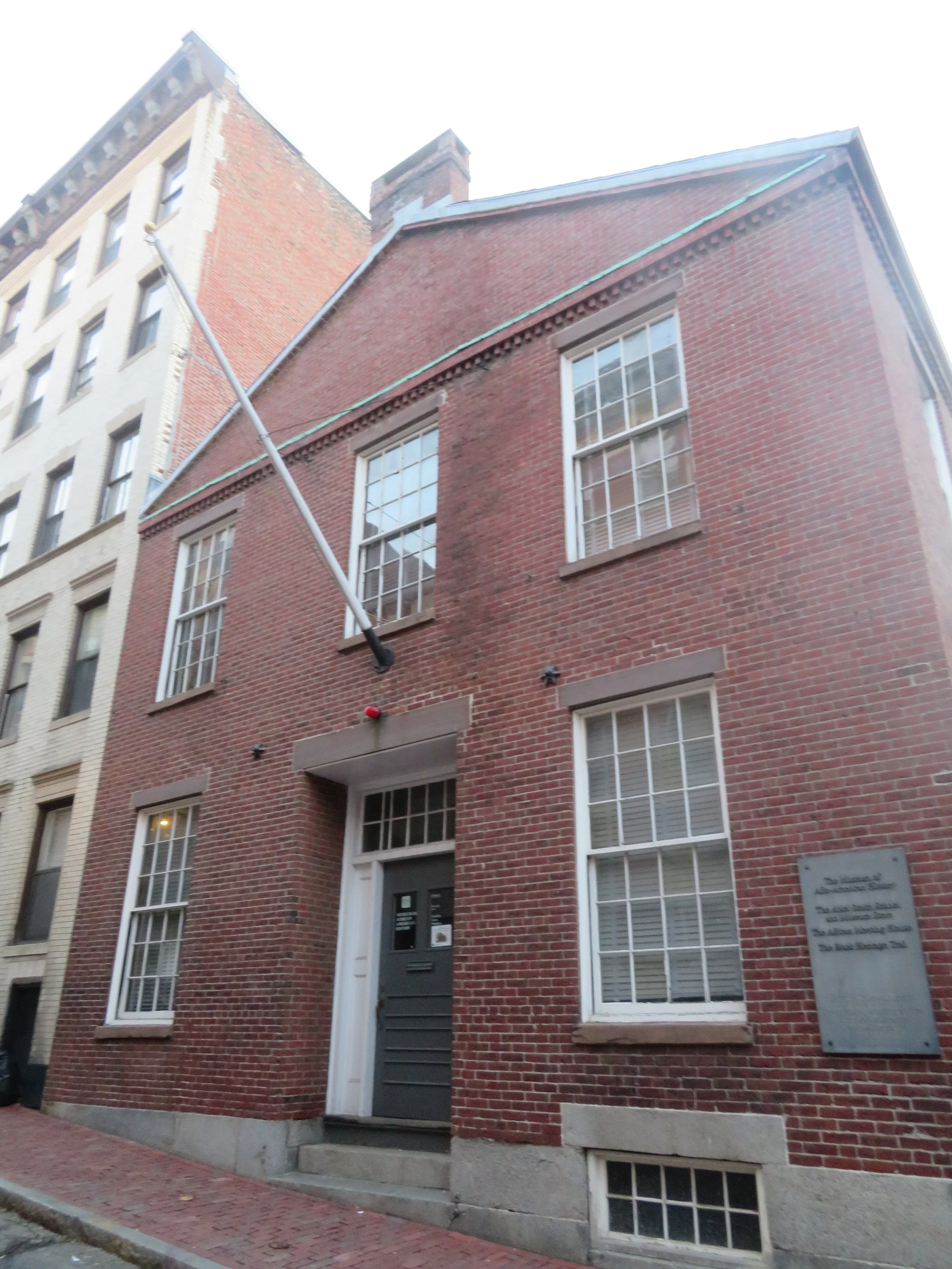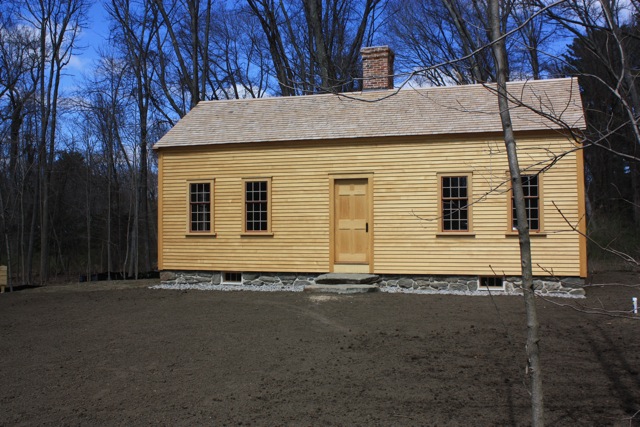
54th Regiment & Robert Gould Shaw Memorial
Beacon and Park Sts., Boston, MA
The 54th Massachusetts Regiment Memorial was designed by nineteenth century sculptor Augustus St. Gaudens to commemorate the first all-African American regiment, recruited in the north, to fight for the Union Army during the Civil War. The project began in 1883 and was completed in 1897. Composed of free African-American men from across the country, and as far away as the Caribbean, the 54th Regiment, led by a white Colonel, Robert Gould Shaw, fought valiantly at the Battle of Fort Wagner in South Carolina during the summer of 1863. Their contributions, including the bravery of the first Congressional medal of honor winner, Sargent William H. Carney, influenced the enlistment of over 185,000 African-American soldiers in the Union Army.
Tufts African American Trail Project

Abiel Smith School
46 Joy St., Beacon Hill, Boston, MA
The Abiel Smith School (est. 1833) was the first public building constructed for the express purpose of educating African-American children. The school was originally located in the basement of the adjacent African Meeting House, but transferred to this building in 1835 after years of pressure from African-American parents and abolitionists. Before the Boston public schools formally desegregated in 1855, the Abiel Smith School supported well known abolitionist teachers Prince Saunders and Susan Paul.
Tufts African American Trail Project

African Meeting House / The Museum of African American History, Boston and Nantucket
46 Joy Street, Boston, MA
The African Meeting House was established in 1806 and is the oldest extant African American church building in the United States. Constructed through the labor and financial support of the city’s African-American community and others, the Meeting House was the site of the African Baptist Church under abolitionist preacher Thomas Paul. The building is currently part of the Museum of African American History (MAAH) and Boston’s Black Heritage Trail.
Tufts African American Trail Project

Charles Street Meeting House
Originally located on Beacon Hill, the Charles Street AME Church began in 1818, when a small group of free men and women created the First African Methodist Episcopal Society. After the Civil War, the Church moved to Charles Street at the base of Beacon Hill, where it continued its important role in African-American history. During the 1890s, for instance, local black feminist and equal rights activist, Josephine St. Pierre Ruffin (1842 - 1924) founded the National Federation of Afro-American Women in the Charles Street Church. In 1939, the church moved to Roxbury, where it remains today a vibrant institution within Boston’s African American community.
iStock Photo

David Walker & Maria Stewart House
David Walker (c. 1796 - 1830) was one of the most radical black abolitionists of his time, publishing his “Appeal” (1829) as a rallying cry for enslaved resistance, free black community organization, and an immediate end to slavery. Born free in Wilmington, North Carolina, Walker moved to Boston around 1825, opened a used clothing shop, and resided in the heart of black abolitionist Boston at this site, then known as 4 Belknap Street. Although Walker lived here only briefly (1827 - 1829), he supported black-led abolition in Boston until his death in 1830, including the Massachusetts General Colored Association (predecessor to William Lloyd Garrison’s New England Anti-Slavery Society), and the early black feminism of fellow abolitionist, Maria Stewart (1803 - 1879). Stewart - the first woman in the United States to deliver a public speech on a political subject - resided here after Walker’s death, during the early 1830s.
Tufts African American Trail Project

Maria Baldwin House
Maria Baldwin c. 1900
196 Prospect St., Cambridge, MA
Maria Baldwin (1856 -1922) was born to Haitian immigrants in Cambridge, and became the first black woman in America appointed principal of a predominantly white public school when she headed the Agassiz School in 1889. During the 1890s, black Harvard students, including W.E.B. Du Bois, spent time in Baldwin’s personal library, which included works by writers of African descent from around the world. Baldwin helped her friend, the feminist Josephine St. Pierre Ruffin (1842 - 1924) found the National Federation of Afro-American Women in 1895, and co-founded Boston’s League of Women for Community Service in 1919. The Agassiz School was renamed the Maria Baldwin School in 2004.
League of Women for Community Service

West Medford Community Center
111 Arlington St., Medford, MA
Prior to the Civil War, free black families with roots in the eighteenth century lived in West Medford along the Mystic River. In the decades after the Civil War, black migrants from the American South and the Caribbean moved to the West Medford neighborhood, where they purchased homes and built community institutions. This expanding community was defined by the river to the south, Boston Avenue to the northeast, and High Street to the northwest. In 1933, black residents built the West Medford Community Center. One of these residents, Walter Isaac, carried pieces of a World War One army barrack to city property on Arlington Street. Over several generations, the Community Center has served many of the social, cultural, and educational needs of the community.
Courtesy of West Medford Community Center

Robbins House
320 Monument Street, Concord, MA
The Robbins House is one of the oldest extant structures in which free African Americans lived in Concord, Massachusetts in the early days of the American Republic. Caesar Robbins (b. 1745), the family patriarch, was enslaved in Chelmsford and served in both the French and Indian, and the Revolutionary War. Two of his six children, Susan and Peter, were the first residents of the house. His granddaughter, Ellen Garrison Jackson, was born in the house in 1823, supported abolitionist and women’s rights in Boston, and worked as a teacher in Freedmen’s Schools in the U.S. South during the early days of Reconstruction.
Courtesy of Robbins House

St. Paul AME Church
37 Bishop Richard Allen Dr., Cambridge, MA
During the 1870s, African Americans from the South, and West Indians from across the Caribbean, migrated to Cambridge, where they settled in the area around Central Square. In 1870, many of these migrants joined native African-American residents to create their own church. In 1873, they formally opened St. Paul’s, originally located at the corner of Portland and Hasting Streets. Today, the Church remains one of the largest and most significant African American congregations in the region.
Tufts African American Trail Project

Twelfth Baptist Church
“Church of the Fugitive Slave in Boston” c. 1854
43-47 Phillips St., Boston, MA
Twelfth Baptist Church was founded in 1840 by a group of African-American Baptists who split from the African Meeting House congregation on Joy Street (then Belknap Street). In the decades before the Civil War, the congregation was known as the “Fugitive Slaves’ Church” for its support of enslaved men and women. Some of the more famous fugitives who used the Twelfth Baptist on their escape to freedom were William and Ellen Craft, Shadrach Minkins, and Thomas Sims.
Anthony Burns: A History

W.E.B. Du Bois House
W.E.B. Du Bois, c. 1900
20 Flagg St., Cambridge, MA
William Edward Burghardt Du Bois (1868 - 1963) was one of the most significant intellectuals of the twentieth century. Following his earlier degrees at Fisk and Harvard Universities, in 1895, Du Bois became the first African American to be awarded a Doctorate in History from Harvard. Born in Great Barrington to a family with deep roots in New England and in Haiti, Du Bois formed lifelong intellectual and personal ties to greater Boston’s African descended community, including the first black Assistant Attorney General, William Henry Lewis, and Guardian editor William Monroe Trotter. He resided at this Flagg Street address while attending Harvard.
Library of Congress

Boston Latin School & Parker Bailey
Boston Latin School c. 1930
78 Avenue Louis Pasteur, Boston, MA
Boston Latin (est. 1635) is the oldest and first public school in the United States. Although the school was once located on School Street in downtown Boston, it moved to its present location in 1922. Founded in the seventeenth century to educate the city’s Protestant male elite - including Samuel Adams and Ralph Waldo Emerson - in 1877, Parker Bailey became the first African American to graduate from the prestigious school.
City of Boston Archives











